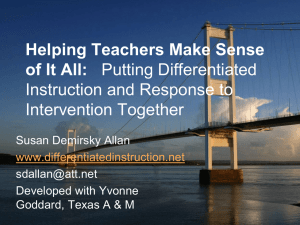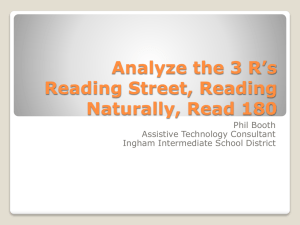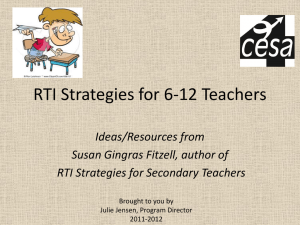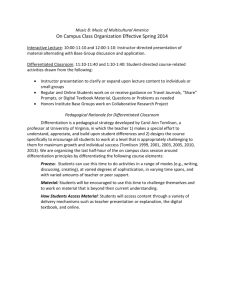ED LEADERSHIP-RTI AND DI
advertisement
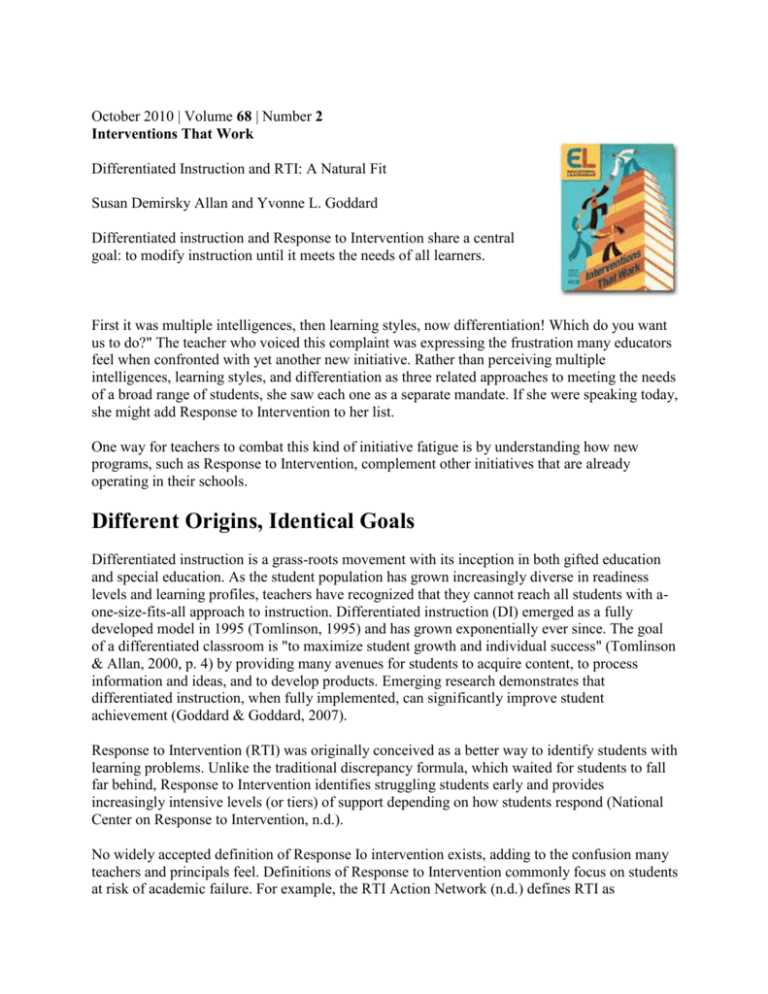
October 2010 | Volume 68 | Number 2 Interventions That Work Differentiated Instruction and RTI: A Natural Fit Susan Demirsky Allan and Yvonne L. Goddard Differentiated instruction and Response to Intervention share a central goal: to modify instruction until it meets the needs of all learners. First it was multiple intelligences, then learning styles, now differentiation! Which do you want us to do?" The teacher who voiced this complaint was expressing the frustration many educators feel when confronted with yet another new initiative. Rather than perceiving multiple intelligences, learning styles, and differentiation as three related approaches to meeting the needs of a broad range of students, she saw each one as a separate mandate. If she were speaking today, she might add Response to Intervention to her list. One way for teachers to combat this kind of initiative fatigue is by understanding how new programs, such as Response to Intervention, complement other initiatives that are already operating in their schools. Different Origins, Identical Goals Differentiated instruction is a grass-roots movement with its inception in both gifted education and special education. As the student population has grown increasingly diverse in readiness levels and learning profiles, teachers have recognized that they cannot reach all students with aone-size-fits-all approach to instruction. Differentiated instruction (DI) emerged as a fully developed model in 1995 (Tomlinson, 1995) and has grown exponentially ever since. The goal of a differentiated classroom is "to maximize student growth and individual success" (Tomlinson & Allan, 2000, p. 4) by providing many avenues for students to acquire content, to process information and ideas, and to develop products. Emerging research demonstrates that differentiated instruction, when fully implemented, can significantly improve student achievement (Goddard & Goddard, 2007). Response to Intervention (RTI) was originally conceived as a better way to identify students with learning problems. Unlike the traditional discrepancy formula, which waited for students to fall far behind, Response to Intervention identifies struggling students early and provides increasingly intensive levels (or tiers) of support depending on how students respond (National Center on Response to Intervention, n.d.). No widely accepted definition of Response Io intervention exists, adding to the confusion many teachers and principals feel. Definitions of Response to Intervention commonly focus on students at risk of academic failure. For example, the RTI Action Network (n.d.) defines RTI as a multitiered approach to help struggling learners. Students' progress is closely monitored at each stage of intervention to determine the need for further research-based instruction and/or intervention in general education, in special education, or both. Because of their differing origins, DI and RTI are usually seen as separate initiatives. We view them, however, as complementary and overlapping. Both approaches are flexible in their implementation and may appear quite different from school to school or even from teacher to teacher. But both are built on two basic concepts: that education is most effective when we treat students as individuals with different levels of readiness, learning profiles, and interests; and that teachers have a professional obligation to help all students succeed. How DI and RTI Fit Together We can make teachers' lives more straight-forward by viewing DI and RTI as two aspects of a whole. At no point in any RTI tier should instruction be provided in a strictly one-size-fits-all format. Differentiation should occur naturally within each tier. Tier 1 of RTI commonly consists of regular classroom instruction provided to all students. Within-classroom differentiation, such as flexible grouping and individualized supports, should be a routine part of such instruction. Some of the time, the teacher may be delivering whole-class instruction. Other times, students will be working toward a common learning goal in flexibly grouped teams or individually. The teams may be composed of learners with similar readiness levels (as determined by a combination of ability and achievement levels), interests, or learning styles. If students are grouped by readiness level, some groups may have more structure in their work or more time to complete their assignment; others may have more complex problems to address. If the students are grouped by learning style, some student groups may be writing, some acting out concepts, some designing a computer presentation, and some working on an oral presentation. In other words, a classroom implementing differentiated instruction and Response to Intervention will first and foremost look like a differentiated classroom. The major component that makes it not just a differentiated classroom but also an RTI classroom is that, in addition to typical classroom assessment (both formative and summative), the teacher keeps detailed records to monitor the progress of students who are struggling and who may need more intensive Tier 2 support. This intense monitoring and documentation facilitates differentiation as well, because it enables teachers to keep a continuous finger on the pulse of students' progress and thus design differentiated lessons more accurately. Students who do not make adequate progress in Tier 1 may be placed in Tier 2, which means that they receive interventions designed to address their areas of difficulty. These interventions may include structural differentiation—providing resources beyond the immediate classroom, such as reading specialists, cluster groups, gifted education services, and so on. Again, the major difference between structural differentiation and services provided in Tier 2 is that Tier 2 requires more extensive documentation and, perhaps, more frequent assessment than would differentiation. Tier 3 is a more specialized level of service that goes beyond what we usually regard as differentiation—for example, students' schedules may include significant amounts of time receiving intensive instruction in special education or gifted classes or alternative schools. But the philosophy remains the same: regarding each student as an individual, asking what each student needs to be successful, and then using whatever services or structures are needed to support that success. Examples of Differentiation and RTI Converging in Classrooms Within-Classroom Differentiation—Tier 1 Instruction in Elementary Math In a 4th grade math classroom, the teacher models how to add fractions with like denominators and provides opportunities for students to practice using individual whiteboards and manipulatives. Then he breaks students into interest groups with the themes of race cars, animals, food, and building blocks. One group of advanced students works on more complex math problems. The teacher and students collect various assessment data throughout the lesson. For example, as the students practice individually and work in groups, the teacher takes notes about which students are struggling and which are completing the work quickly and accurately. After group work is complete, students pull out individual math folders, take a quick, 10-question quiz, and graph the number of problems they answered correctly. Structural Differentiation—Tier 2 Interventions in 10th Grade World History In a high school, 10th graders take world history in heterogeneous classes in which teachers provide flexible grouping and differentiated learning tasks. Teachers give biweekly quizzes on vocabulary and comprehension; students chart their scores to observe their progress. For students who either fail to master the material or are unchallenged by the level of difficulty, the school's four 10th grade world history classes provide structural differentiation through cluster grouping. For some assignments, struggling students (including some with IEPs) are grouped across classes to receive extra help from a special education teacher; advanced students who need more challenge are also grouped across classes for enrichment projects. For students who need still more intensive help, the special education teacher consults with a reading specialist who provides additional individual instruction and support with readings and assignments. Highly Specialized Differentiation—Tier 3 Interventions in Middle School Language Arts A middle school has some students whose reading skills are significantly delayed and who have not made adequate progress with Tier 1 instruction or Tier 2 interventions. Some of these students receive intensive, remedial language arts instruction in a self-contained special education classroom for one or two class periods each day. A few students attend an alternative school that uses instructional methodologies that nurture their particular learning styles. Even at this level of intervention (Tier 3), teachers differentiate instruction. For example, in the self-contained language arts class, they may give students choices of how to process content (such as listening to audiotapes or reading with the teacher) or provide opportunities to create a variety of products. Emphasize the Convergence, Not the Difference We believe it may make the most sense to think of Response to Intervention as a subset of differentiated instruction. Differentiated instruction applies to all students, including those who struggle and need academic and behavior supports. Response to Intervention is a way of focusing on students who may need increasing levels of support to experience success. However, the crucial goal of both models is to modify instruction so that it meets students' individual needs and thus nurtures their success. Much of the frustration that educators experience as they attempt to implement multiple instructional approaches could be avoided with improved professional development, in which teachers are introduced to the concepts and research and then supported as they implement these initiatives over time. Teachers also need time to collaborate as they work to learn and use new instructional approaches (Goddard, Goddard, & Tschannen-Moran, 2007). Such professional development should be designed to streamline application of new knowledge, with a focus on research-based practices that can be implemented simultaneously. Differentiated instruction and Response to Intervention can and should be presented as mutually supportive. Teachers have a tough job meeting the demands of national and state initiatives, parents, highstakes testing and accountability, and increasing student diversity. We can support teachers by showing the convergence among ideas that lead to best practice rather than emphasizing the different vocabularies and terms associated with different models. Fortunately, differentiated instruction and Response to Intervention are a natural fit. We can approach them as such. References Goddard, Y. L., & Goddard, R. D. (2007, November). A statewide study of the effects of differentiated instruction on fourth grade students' mathematics and reading achievement. Paper presented at the University Council for Educational Administration annual conference, Washington, DC. Goddard, Y. L., Goddard, R. D., & Tschannen-Moran, M. (2007). A theoretical and empirical investigation of teacher collaboration for school improvement and student achievement in public elementary schools. Teachers College Record, 109, 877–896. National Center on Response to Intervention. (n.d.). Home page. Retrieved from http://www.rti4success.org/. RTI Action Network (n.d.). What is RTI? Retrieved from www.rtinetwork.org/learn/what. Tomlinson, C. A. (1995). How to differentiate instruction in a mixed ability classroom. Alexandria, VA: ASCD. Tomlinson, C. A., & Allan, S. (2000). Leadership for differentiating schools and classrooms. Alexandria, VA: ASCD. Susan Demirsky Allan is a consultant and recently retired as assistant superintendent for curriculum, assessment, instruction and technology, Grosse Pointe Public School System. Yvonne L. Goddard is assistant professor, Educational Psychology Department, Texas A&M University.
